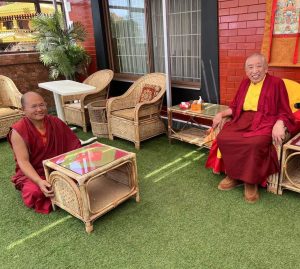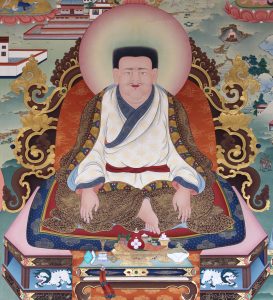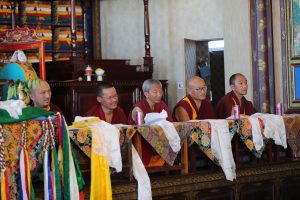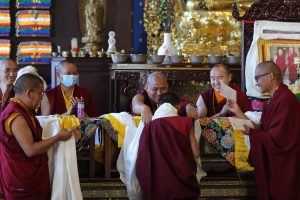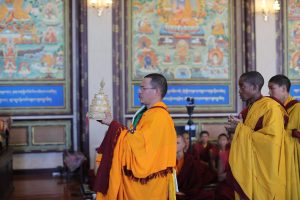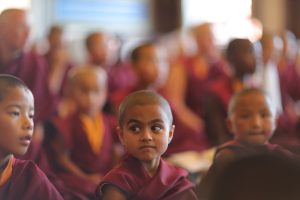A full tantric curriculum over 21 years – The first year of an audacious endeavour
Today, 27th April 2022, sees the conclusion of the first year of Thrangu Sekhar Retreat Centre’s 21 and 26 year study and practice programmes based on Marpa’s tradition of the tantras. To view the programmes click the following link:
https://www.druponrinpoche.org/en/the-21-or-26-year-curriculum-of-thrangu-sekhar-retreat-centre/
What follows is taken from several talks that Drupon Khen Rinpoche gave in the Spring of 2021 regarding his vision for this ambitious undertaking:
Tibetan Buddhism is known as the Buddhist tradition that emphasises the tantras, or we can say the Vajrayana. And there is good reason for this when we look at the practices the Tibetans of the past and present have prioritised. But on the side of study, Tibetans place very little emphasis on the tantras; few shedras (Buddhist colleges) include much in the way of tantric Buddhism, the vast majority only offer sutra based teachings.
I suppose part of the reason for this is that one needs a thorough grounding in the sutras before one can understand the tantras, and the sutra teachings themselves are vast and profound – it takes many years to cover the basics of each area in any depth.
But if the tantras are not taught the teaching traditions (the transmission or lineage) for the different texts become lost or broken. And we see that this has happened with many of the tantric texts of our Kagyu school that were transmitted through Marpa.
In general, Kagyupas have never really emphasised the study of the scriptures, but have focused on receiving and practising the pith-instructions. This started to change around the time of the 7th, 8th and 9th Karmapas, if we look at the Karma Kagyu school, but then with the political upheaval in Tibet during the time of the 10th Karmapa in the 17th century, the Kagyu school as a whole was pretty much wiped out, with only a few embers kept alive here and there. And truth be told, those embers were never fully rekindled. During the time of the 14th and 15th Karmapas in the 19th and early 20th century, particularly through the activities of the 9th Situ Pema Nyinje and Jamgon Kongtrul Rinpoche the Great and others, the situation improved and the signs of a full revival looked promising but then the Cultural Revolution of China struck Tibet and many of the lamas had to flee and try to re-establish themselves, their monasteries and traditions under extremely difficult circumstances in India etc.
If we look at the writings of Jamgon Kongtrul Lodro Taye, he often states in his introductions or concluding remarks that one of the reasons he wrote a particular text was because the lineage for the texts on that particular topic from the past masters had been broken.
It must be said that the other major schools of Tibetan Buddhism have done a better job of maintaining the richness of their transmissions than we Kagyupas have. For example the Nyingmapas have kept the line of transmission for Longchenpa’s teachings intact. They teach and give the transmissions regularly. Similarly for the Gelukpas and the teachings of Tsongkhapa, and the Sakyas and the teachings of Gorampa for example. How many of us who call ourselves Kagyupas have received teachings and transmissions for the instructions of Marpa, Milarepa, Gampopa, Karmapa Dusum Khyenpa, Pamo Drupa, etc etc? How many of us even know the names of the texts they wrote and taught? If we do not know, and the general point I’m making here is valid, it is important that we recognise that we have a problem, because then we can take steps to rectify it.
Maybe it’s strange for a nobody like myself to talk about such things when I have no influence or abilities to assist in the propagation of Buddhism in any meaningful way. But I do have a genuine love and sense of concern for the teachings and seeing such valuable transmissions being lost is very upsetting.
Recently, with the arrival of the children here at the retreat centre, I found myself in the position of needing to devise a curriculum of study. So I reached out to various dharma friends who are khenpos and so on, and much more knowledgeable and experienced than me, to ask their advice and receive their input. One point that they all expressed is that mere theoretical study without teachings and time dedicated to mind training (the contemplation of impermanence etc) is a recipe for disaster. Many serious students of Buddhism these days are becoming hard-headed and arrogant through their studies. This is something I have seen and been worrying about myself, and hearing it from them gave me greater confidence in my plan to combine practice and study in the children’s education. Although this is certainly not a new approach, for example we don’t hear of there having been separate shedras and retreat centres at the height of Buddhism in India. The teachings were heard, reflected upon and practised in unison.
The 21 year curriculum is mainly for the slightly older group of children (early teens) who have already covered the basics of reading and writing etc, and the 26 year programme is for the younger group (ages 5 to 10), who are only just learning to read etc. It is very important that the children, alongside their Buddhist education, also learn something of modern science, mathematics, Western philosophy and literature. And that they also learn their native languages beyond mere fluency. The Nepalese children need to learn Nepali, the Chinese children need excellent Chinese and we need to ensure that the African children speak a high level of French and Swahili, and are not estranged from their own culture. But above all else, what will make these children special is if they become highly learned in the sutras and tantras, and become decent practitioners.
The first 10 years of the 21 year programme will focus on sutra level teachings and the final 11 years will be dedicated to the study and practice of the tantras, Vajrayana.
Besides the children, you Western and Chinese students [in the retreat centre], who have given up everything else to pursue the study and practice of Buddhism full-time, will also have the opportunity to join the programme. Now you can reap the rewards of the time and effort you have put into learning Tibetan. As things stand at moment, it would be impossible for you to receive these teachings if you didn’t speak Tibetan. Most of the texts that will be taught have not been translated into English, and even if they were, they are too long to be taught with an interpreter.
But whether you join the programme or not, it is not a decision you should take lightly. It will not be easy. It wouldn’t suffice to just be present in the class and then go back to your room and place the text on the shelf until the next class. There will be examinations: oral, written and compositional examinations, as well as debating.
You should also think about the amount of money that will be spent to provide for you over the 21 years. When everything is accounted for it is a massive sum that needs to be found for each of you; so would it be right to commit to the programme and then only participate half-heartedly? From my side and from the side of the gompa, this is not being undertaken because we haven’t got anything better to do. We have a plan and a vision, and the hope that those who participate receive tremendous benefit from what will be imparted, and that they in turn will pass these benefits on to others.
You will not need to attend the secular studies classes, on poetry and grammar and so on, because during these classes you will be in practice sessions. Organising the daily timetable will be tricky, because we need to find time not only for the classes and the group meditation sessions, but also time and space for you to study what you have learnt in the classes by yourself; to assimilate and reflect on the knowledge being imparted. And many of you are translating texts, which also needs time. But I’m confident we can make it work.
Some of you who are older might be doubting whether you are a little old to embark upon a 21 year programme of study, but the way that I see it is that anyone who has gone forth from the worldly life and become a monk or a nun, like most of you have, what else is there to do other than spend your time studying and practising. If you can reach the end of your life having spent your days learning and practising, what could be better than that? The very reason we go forth is to have a good situation to study and practise the dharma.
If you are under 50, then personally I think it would be good for you to join the programme. If you are over 50 and wish to join, you are more than welcome, but you have to be able to keep up, and not let yourself be a cause for holding others back. Basically, whether you join or not is for each of you to think about and decide for yourselves.
I must admit the 21 year programme as a whole is rather ambitious, I’m not sure that it will go exactly to plan, but you have to think big when planning such projects. Myself and Khenpo Wangchuk will do the bulk of the teaching, but we will need to travel to receive some of the rarer transmissions. If possible we will also invite lamas and khenpos who are specialists in some of the topics being taught. Whatever the case, we will need to invite other teachers. We are fortunate in that Lama Samten came to the retreat centre looking for meditation instruction, he is a good practitioner and has completed the whole Geshe programme in one of the main Gelukpa seats, so he will teach logic and debate.
I think it is very important that we invite teachers from all four major schools of Tibetan Buddhism. One of the manifestations of the hard-headedness I spoke about earlier is strong attachment to one’s own school and aversion to other schools. This is very prevalent these days. If you go online you see all sorts of fighting and quarrelling about which school is better etc, and it is mainly those who have been through shedra, and many times those who hold the titles of khenpo and geshe, who are the most strident. I don’t know how they dare say some of the things you see being posted, it seems even the Buddha himself is not spared their scorn.
The very function of the dharma is to remedy attachment and aversion, but if someone develops attachment and aversion in relation to the dharma – because of how they have been taught or through how they personally relate to the dharma – the medicine itself has become toxic. So while there is still hope for those who have normal worldly attachments and aversions, there is little that can be done for those who have become impervious to the treatment the dharma has to offer.
One of the sources of this hard-headedness, as I see it, is a lack of exposure to the teachings of the other schools. I was fortunate when I was studying, I had the chance to study with masters of several different traditions, so I came to a first-hand appreciation of how the dharma of each school is pure dharma. I have equal faith in the dharma of all the schools. In fact back home in my youth this was the norm, although our village was connected to a Karma Kagyu monastery, if someone died etc, we would invite lamas from all the other monasteries of the area to do prayers, and vice versa. This wasn’t done out of some political agenda, or as an interfaith scheme or anything like that. The local people had genuine faith in good monks and nuns regardless of what tradition they belonged to. Also, when I was studying in Serta Larunga, there was no attachment and aversion for the different schools. For example, although Khenpo Jigme Puntsok Rinpoche was a Nyingmapa, as was most of the community, at one point he strongly encouraged all the monks and nuns to memorise Tsonkhapa’s Three principal Aspects of the Path, and and the Thirty-Seven Practices of a Bodhisattva, neither of which are Nyingma texts, and nobody thought it was an unusual demand.
I want to make sure that the children and you adults who participate in the programme see for yourselves how equally wonderful the dharma of the other schools is, so I included texts authored by masters of the other traditions, and hopefully we will be able to invite khenpos and geshes from the respective traditions to teach them.
My hope is that on completion of the programme, the children in particular (who will obviously be well into adulthood by the end of the programme) will be inspired to follow the way of true practitioners and head to the mountains and forests and spend at least some time practicing in solitude with no fixed abode. Or, alternatively, that they go on to benefit beings in other ways, such as by teaching and nurturing their own students.
Anyway, these are some of my thoughts about the upcoming programme, if you wish to join then let me know within the next couple of weeks.
[The programme started on April 27th 2021 with 72 participants (16 children and 38 adults on the 21 year programme, and 18 children on the 26 year programme.) With new students having joined in 2021-2022 there are now 96 participants in total – 56 on the 21 year programme (16 teenagers and 40 adults), and 40 children on the 26 year programme. The students / practitioners have come from 20 different countries but most have been living in the retreat centre for at least several years already. They will continue to live, study and practise full-time in the retreat centre.]

